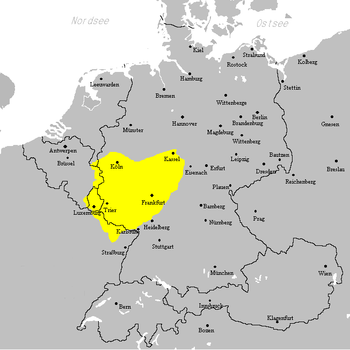West Central German dialects
West Central German together with East Central German ( Thuringian-Upper Saxon dialect group and others) form Central German . It comprises exclusively Franconian dialects and is spoken mainly along the Middle and Upper Lower Rhine . The language area includes in particular the federal states of Hesse , Rhineland-Palatinate and Saarland , the Grand Duchy of Luxembourg and a small part of North Rhine-Westphalia in the south-west of the country, eastern Belgium , a small area of the Netherlands near Maastricht and French areas near the border in Lorraine . Most of the West Central German languages did not follow the second sound shift . In all dialects of West Central German, it says appel instead of 'apfel' and Parre (r) instead of 'Pfarrer'. Furthermore, for example, in the Cologne and Trier area ( Middle Franconian ), similar to the southern areas of Lower Saxony (Low German) ( Westphalian , East Westphalian ), dat , et is said for “that” and “it”. Overall, however, these dialects are more closely related to the Lower Franconian languages in the northwest, i.e. in the Netherlands, than to the Lower Saxon language. South of the Sankt Goarer line or "dat-das-line", in the Palatinate or Hessian , it is called des and es . Sometimes referred to as " high-Frankish summarized dialects" dialects south of Speyer line or "Appel / Apfel-line", ie East Frankish and Südfränkisch have the second sound shift, however, fully participated (in this case it is called for. B. apple instead of "Appel") , which is why these dialect groups are often counted among the Upper German dialects . The development of the characteristics of the 2nd sound shift is very different, which is why the West Central German language area is criss-crossed by a series of dialect boundaries ( isoglosses or "lines"), mostly running in an east-west direction , which are collectively called " Rhenish subjects ".
Dialects and dialect groups of West Central German
-
Middle Franconian
- Ripuarian , also Ripuarian-Franconian - in the literature of the 18th and early 19th centuries often referred to as Middle Franconian - these also include Kölsch , Öcher Platt , Eischwiele Platt , Dürener Platt (in North Rhine-Westphalia and Belgium , as well as in the southern tip the Netherlands )
-
Moselle Franconian (in Rhineland-Palatinate in the Moselle region, southern Eifel , northern Hunsrück , Westerwald , Middle Rhine and Lahn area , in north-western Saarland and in North Rhine-Westphalia in Siegerland )
- Middle Lorraine (in France in the Moselle department in the Niedtal valley )
- Luxembourgish , also Lëtzebuergesch (in the Grand Duchy of Luxembourg , in Belgium in the Areler Land and in France in the northwest of the Moselle department)
-
Rhine Franconian
-
Palatinate
- West Palatinate (in Rhineland-Palatinate in the West Palatinate and the southeastern Saarland )
- Vorderpfälzisch (in Rhineland-Palatinate in the Vorderpfalz and in France in northern Alsace )
- Electoral Palatinate (in Baden-Württemberg in the Electoral Palatinate and in Hesse in southern Starkenburg )
- Ostlothringisch or Saarlothringisch (in France in the east of the Moselle department in the so-called. Krumme Elsass )
- Bukovinian German (extinct)
-
Hessian
- South Hessian dialects (in Hesse in Starkenburg and in the Rheingau , in Rhineland-Palatinate in Rheinhessen and in Bavaria in western Lower Franconia )
- Lower Hessian dialects (in Hesse around Kassel and Bad Hersfeld , and in western Thuringia )
- Upper Hessian dialects (in Central Hesse including Hochtaunus and Wetterau )
- East Hessian dialects (around Fulda and in the Hessian Rhön )
-
Palatinate
On the northern border of the West Central German-speaking area, there are smooth transitions to the Dutch- speaking area, German-Dutch and Low German . On the southern border of the West Central German-speaking area there are smooth transitions to East Franconian , South Franconian and Alemannic .
The Marburg linguist Alfred Lamelli proposes a spatially and factually somewhat narrower term for West Central German dialects, which roughly corresponds to the Ripuarian, Limburg and northern Moselle-Franconian dialects. As a result of new distance studies, the above-mentioned West Central German dialects are much more independent than High German.
vocabulary
The vocabulary of West Central German dialects is recorded and described in the Rhenish dictionary (dialects of the former Prussian province of Rhineland), in the Siegerland dictionary in the Palatinate dictionary (Palatinate dialects), Luxembourgish dictionary (Luxembourgish dialects), in the dictionary of German-Lorraine dialects (Lorraine dialects) , in the Hessen-Nassau dictionary (dialects in Hessen-Nassau) and in the South Hessian dictionary (Rhine-Hessian dialects).
See also
literature
- Alexandra N. Lenz: Structure and dynamics of the substandard. A study on West Central German (Wittlich / Eifel). Stuttgart 2003.
Web links
Individual evidence
- ↑ Aachener Zeitung of April 7, 2015 a . a., last accessed on April 20, 2015.
